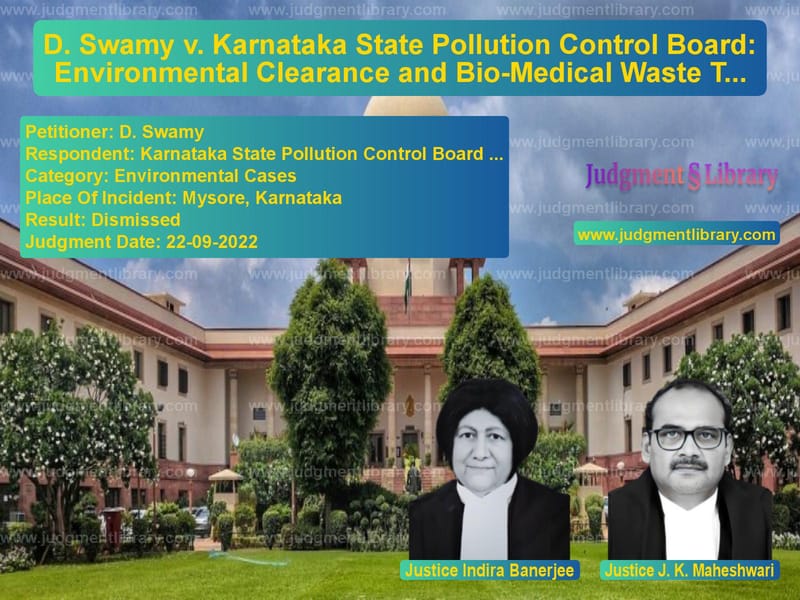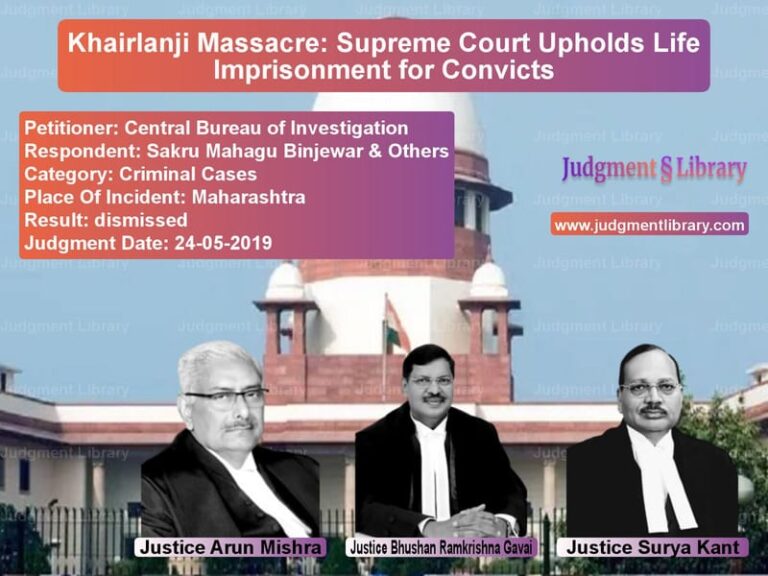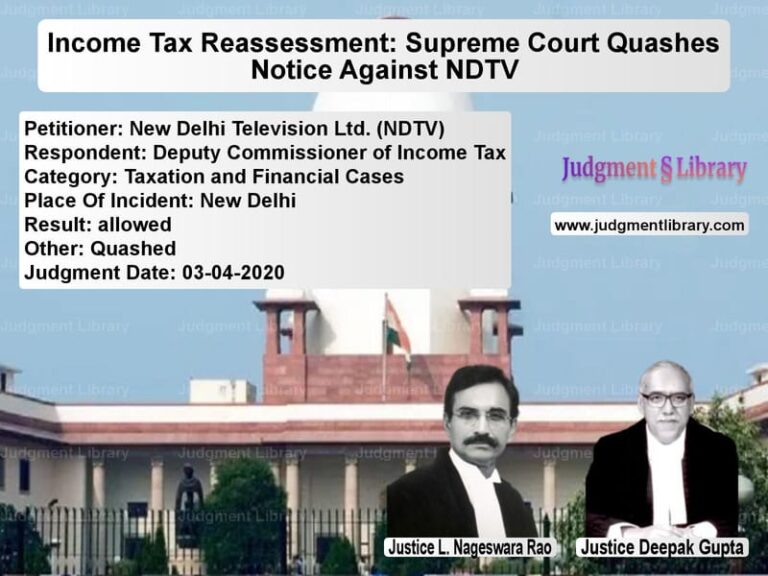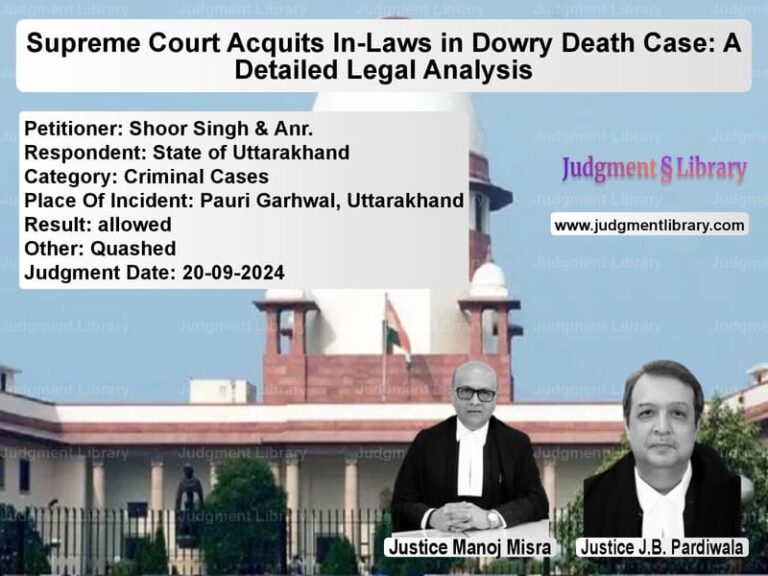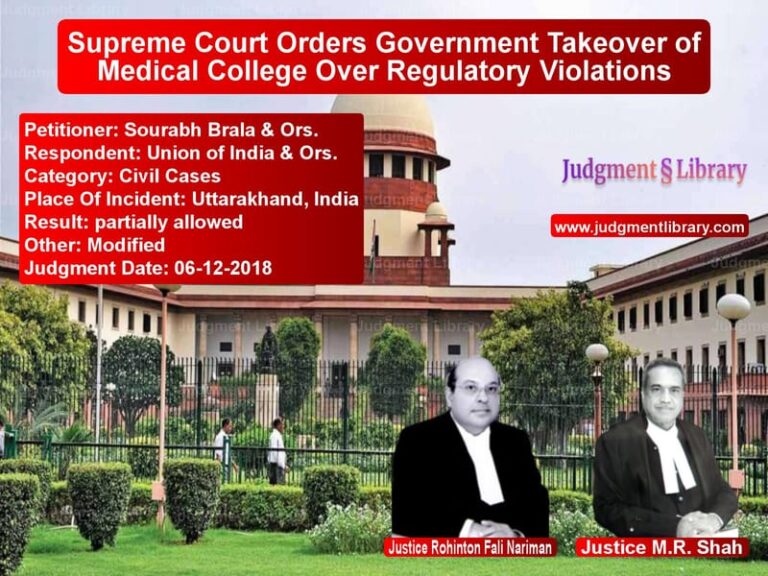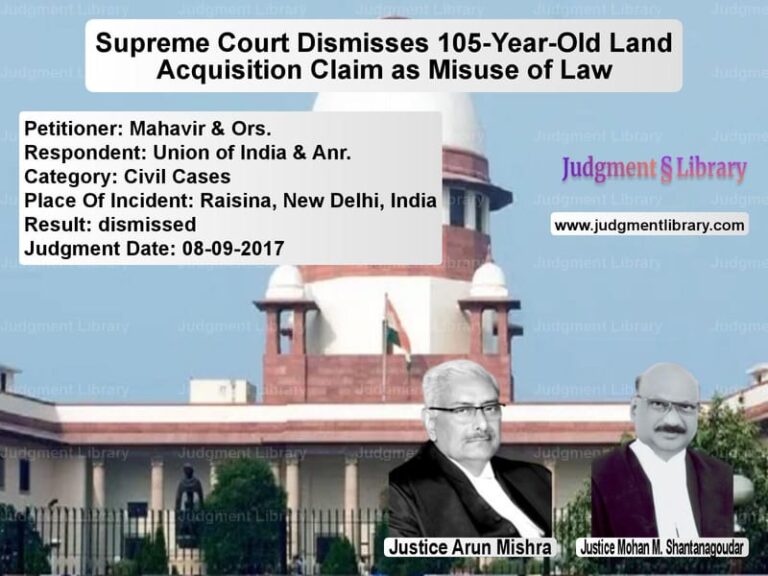D. Swamy v. Karnataka State Pollution Control Board: Environmental Clearance and Bio-Medical Waste Treatment Facility
The case of D. Swamy versus the Karnataka State Pollution Control Board and others revolves around an appeal challenging the order passed by the National Green Tribunal (NGT), which dismissed the application filed by the appellant under Section 18(1) read with Section 14 of the National Green Tribunal Act, 2010. The appellant, D. Swamy, sought the closure of the Common Bio-Medical Waste Treatment Facility operated by Respondent No. 3 due to alleged non-compliance with the provisions of the Environmental Impact Assessment (EIA) Notification, 2006, as amended in 2015. This case is important in the context of understanding the legal requirements for environmental clearance and the treatment of bio-medical waste in India.
The appellant’s argument is based on the contention that the Common Bio-Medical Waste Treatment Facility, operated by Respondent No. 3, had not obtained the necessary Environmental Clearance (EC) under the 2006 EIA Notification before its establishment. The appellant further argued that this non-compliance warranted the closure of the facility. The appellant had filed an application with the NGT seeking a direction to close down the facility, citing concerns over environmental pollution and public health risks arising from the improper handling of bio-medical waste.
The facts of the case highlight that Respondent No. 3 had applied for consent to establish the facility in 2012, which was granted by the Karnataka State Pollution Control Board (KSPCB). However, the appellant contended that the facility’s operation was in violation of environmental regulations, particularly the EIA Notification, which mandates that projects like bio-medical waste treatment facilities should obtain EC from the Ministry of Environment, Forest and Climate Change (MoEF&CC). This was particularly emphasized after the amendment to the EIA Notification in 2015, which included new provisions regarding environmental clearance for bio-medical waste treatment plants.
On the other hand, the respondents, including the KSPCB and Respondent No. 3, contended that the facility had been duly authorized by the KSPCB to operate under the relevant environmental protection laws. They argued that the facility had complied with the necessary pollution control measures under the Water (Prevention and Control of Pollution) Act, 1974, and the Air (Prevention and Control of Pollution) Act, 1981. The respondents further submitted that the facility’s operation did not require an Environmental Clearance as per the provisions of the law at the time it was established. They highlighted that the requirement for an EC was only introduced in 2015, long after the establishment of the facility.
The NGT, in its decision, ruled that the closure of the facility was not warranted, as it had received consent from the KSPCB and was operating in accordance with the pollution control measures prescribed under the relevant laws. The NGT also dismissed the appellant’s application on the grounds that the requirement for an EC under the 2006 EIA Notification did not apply retrospectively. The NGT further held that the facility was in compliance with environmental regulations and could continue to operate while adhering to the prescribed environmental norms.
The appellant, dissatisfied with the NGT’s ruling, filed an appeal before the Supreme Court, challenging the dismissal of the application for the closure of the facility. The appellant argued that the NGT had erred in not considering the mandatory requirements of the EIA Notification, 2006, and the subsequent amendments that made obtaining an EC a necessity for such facilities. The appellant also contended that the NGT had failed to consider the adverse environmental impact caused by the operation of the facility without the required environmental clearance.
The Supreme Court, in its judgment, addressed several critical issues, including the applicability of the EIA Notification to bio-medical waste treatment facilities, the retrospective nature of the requirement for EC, and the role of the NGT in enforcing environmental regulations. The Court reviewed the provisions of the EIA Notification, particularly the 2015 amendment that introduced new rules for bio-medical waste treatment plants. The Court observed that while the requirement for EC was made applicable to such facilities post-2015, the retrospective application of this requirement was a complex legal issue that needed careful examination.
The Court also considered the arguments presented by the respondents, including the KSPCB and Respondent No. 3, who argued that the facility had been legally established and was operating in compliance with all relevant environmental regulations at the time of its establishment. They emphasized that the facility had been granted consent by the KSPCB, which had the authority to regulate and approve such projects under the provisions of the Environment (Protection) Act, 1986. The respondents also highlighted that the facility had implemented the necessary pollution control measures and was contributing to the proper disposal of bio-medical waste, which was crucial for preventing environmental contamination.
After hearing the arguments and considering the facts of the case, the Supreme Court upheld the decision of the NGT and dismissed the appeal. The Court ruled that the facility’s operation did not warrant closure, as it had been legally established and was in compliance with the pollution control regulations at the time of its establishment. The Court further observed that the requirement for an Environmental Clearance under the EIA Notification was not applicable retrospectively and that the facility could continue to operate as long as it adhered to the prescribed environmental norms.
The Court’s ruling emphasized the importance of balancing environmental protection with the practical needs of industries that contribute to public health and the economy. The Court acknowledged the concerns raised by the appellant regarding the environmental impact of the facility but concluded that the facility had been operating in compliance with the applicable laws and regulations. The decision of the Supreme Court in this case highlights the challenges faced by the judiciary in interpreting and applying environmental laws, particularly when dealing with issues of retrospective applicability and the balance between environmental protection and economic development.
This case also serves as an important precedent for future legal challenges involving bio-medical waste treatment facilities and other industries that operate in compliance with environmental regulations but may not have obtained the necessary clearances due to changes in the law. It underscores the importance of ensuring that industries are held accountable for their environmental impact while also providing a fair legal framework for the operation of such industries.
Read also: https://judgmentlibrary.com/supreme-court-quashes-closure-order-for-gujarat-cold-rolling-steel-unit/
Petitioner Name: D. Swamy.Respondent Name: Karnataka State Pollution Control Board and Ors..Judgment By: Justice Indira Banerjee, Justice J. K. Maheshwari.Place Of Incident: Mysore, Karnataka.Judgment Date: 22-09-2022.
Don’t miss out on the full details! Download the complete judgment in PDF format below and gain valuable insights instantly!
Download Judgment: d.-swamy-vs-karnataka-state-poll-supreme-court-of-india-judgment-dated-22-09-2022.pdf
Directly Download Judgment: Directly download this Judgment
See all petitions in Environmental Cases
See all petitions in Public Interest Litigation
See all petitions in Damages and Compensation
See all petitions in Contract Disputes
See all petitions in Judgment by Indira Banerjee
See all petitions in Judgment by J.K. Maheshwari
See all petitions in dismissed
See all petitions in supreme court of India judgments September 2022
See all petitions in 2022 judgments
See all posts in Environmental Cases Category
See all allowed petitions in Environmental Cases Category
See all Dismissed petitions in Environmental Cases Category
See all partially allowed petitions in Environmental Cases Category

